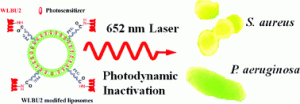A novel bacteria-targeting liposomal formulation has been developed by a team in Germany which improves photodynamic antimicrobial chemotherapy (PACT) by using the bacteria-targeting ability of antimicrobial peptides (AMP).
In PACT laser light is used to trigger a photosensitizer (PS) to an activated state, this results in the transfer of energy to surrounding oxygen leading to generation of reactive oxygen species (ROS). These ROSs oxidise biological molecules resulting in cytotoxicity. PACT has attracted significant attention in the last decades as a potential strategy to treat bacterial infections, especially antibiotic resistant species due to a broad spectrum of action and a belief that bacteria will not easily develop resistance to ROSs, furthermore PACT is more phototoxic to bacteria than mammalian cells.
 Tempoforin is one of the most potent PSs but it cannot be administered alone as it is highly hydrophobic. A suitable delivery system is necessary and liposomes are an attractive choice and have been utilised before, however, when liposomes containing tempoforin are applied to an infection site they are also applied to cells nearby resulting in side effects. To avoid this is it necessary to target the liposomes to bacteria.
Tempoforin is one of the most potent PSs but it cannot be administered alone as it is highly hydrophobic. A suitable delivery system is necessary and liposomes are an attractive choice and have been utilised before, however, when liposomes containing tempoforin are applied to an infection site they are also applied to cells nearby resulting in side effects. To avoid this is it necessary to target the liposomes to bacteria.
A promising source of bacteria-targeting ligands may come from AMPs which are cationic amphipathic peptides found ubiquitously in most classes of life forms where they are part of the innate immune system. They are able to interact with and penetrate negatively charged lipids in bacterial membranes forming membrane pores resulting in damage. Their mode of action, like PACT, results in a broad range of action and low susceptibility to antibiotic resistance.
Alfred Fahr and co-workers used a synthetic AMP called WLBU2 which has broad antimicrobial activity and also shows specific and effective binding to various microbes. By formulating tempoforin-loaded liposomes conjugated on their surface with WLBU2 they were able to improve PACT efficiency on both gram-positive and gram-negative bacteria.
To find out more read the full article. Free to read until August 19th.
Antimicrobial peptide-modified liposomes for bacteria targeted delivery of temoporfin in photodynamic antimicrobial chemotherapy
Kewei Yang, Burkhard Gitter, Ronny Rüger, Gerhard D. Wieland, Ming Chen, Xiangli Liu, Volker Albrecht and Alfred Fahr
Photochem. Photobiol. Sci., 2011, DOI: 10.1039/C1PP05100H










